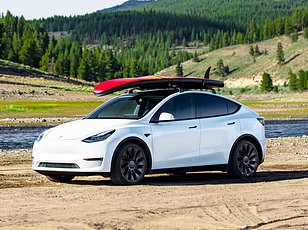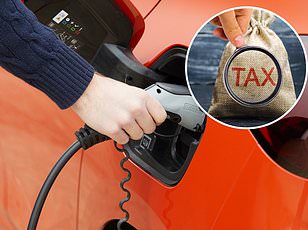- Swedish EV brand's flagship SUV offers sports car driving and 380-mile range
- Prices start from £75,900 but the pricier Launch Edition is sold out already
Polestar is arguably Tesla's biggest rival in Britain and, at this point, one of the better-known exclusively electric brands across Europe.
But until now the standalone Swedish firm – formerly the green performance arm of Volvo – has sold only the Polestar 2 while teasing plans to add to the line-up in a bid to take on the might of Elon Musk and his monumental EV empire.
And finally it has with the arrival of the Polestar 3, a performance luxury SUV that's looking to pinch sales from the world's most bought car, the Model Y.
Does it have the right ingredients to do it? We've driven it to find out.

The Polestar 3 is a luxury SUV EV from the Swedish racing-inspired brand, and is only the second car Polestar has made

The 3 starts at £75,900 with the Performance variant costing from £81,500. The Long range Dual motor does 392 miles on a single charge, while the Performance pack drops that to a (still very long) range of 348 miles
Polestar – where did it come from? A very brief history
In the lifespan of car manufacturers, Polestar is a relative baby.
The one-time Volvo racing team was born back in 1996 under the (far less memorable and more laundry-detergent-sounding) name of Flash Engineering.
It was re-branded in 2005 to Polestar – a nod to frozen north Sweden and pole position on the grid – and became Volvo's official performance partner in 2009.
Volvo then bought Polestar in 2015, and in 2017 switched it across to an EV-only maker. It became a separate branded marque, no longer a part of Volvo cars.

Polestar, the EV brand, was born with the Polestar 2 which launched in 2019 - deliveries came in early summer 2020

The Polestar 4 - a coupe SUV with no rear window - is launching at the same time as the 3, which makes Polestar a three-car brand from now on
Polestar 3 vs Tesla Model Y
In October 2020, Polestar opened its first retail ‘Space’ in Westfield Shopping Centre in West London, to showcase the brand’s first all-electric car, the Polestar 2, which went on sale in the UK in the height of Covid lockdowns in summer 2020.
I remember visiting the space in May 2021, and test driving the Polestar 2 around the same time. Everyone was coming out of lockdown hibernation and suddenly there was this new EV brand with a retail space near Zara, and a car on the road people couldn’t identify.
Passers-by would turn and stare, with the cogs clearly turning in their head as they attempted to decipher the logo on the bonnet and boot lid.
Fast forward four years, and Polestar has now established its identity.
But while other manufacturers like Volkswagen (which is admittedly a giant of automotive manufacturing) have gone from one EV to multiple (VW now has six electric models you can currently snap up), Polestar has been stuck on just one - albeit best-selling model - since 2019.
So, the launch of the Polestar 3 is a huge moment for the brand, especially as Polestar has been logged in a head-to-head battle against just the Tesla Model 3 for the best part of half a decade.
Now it goes up against the US firm's most successful import of late - the Model Y SUV.

The Tesla Model Y has been an unequivocal success story. It was the best-selling car in Europe and globally last year - the first time an electric car has solidified the number one slot
Not only was this Britain's best-selling EV last year (racking up almost 36,000 registrations), it was the most-bought car of any fuel type across Europe and globally in 2023.
It means Polestar has entered the toughest competition imaginable with the 3.
However, the early signs look promising...
Polestar says sales for the Launch Edition - the first arriving in the UK in a matter of weeks - have already sold out until 2025.
The cheapest version, called the Long Range Dual Motor, will arrive later in the year starting from £75,900.
This covers 0 to 60mph in 4.8 seconds, has a top speed of 130mph, produces and has a claimed range of 392 miles - the longest o the two variants sold.
The Model Y rival to this is the Long Range All-Wheel Drive, which around £20,000 less, has the same 0-to-62mph sprint time and similar 135mph top speed, though - importantly - has a shorter range of 331 miles.
You’ll need to pay at least £81,500 for the Long range Dual motor with Performance pack if you want slightly improve stats: 0 to 60mph in 4.5 seconds; 510bhp; and the same top speed.
Range with the Performance pack drops to 348 miles, which for a lot of people is probably not worth the marginal performance improvement.
Comparatively, the Polestar 2 Long range Dual motor (which is around 500kg lighter) has 416bhp, does 0 to 60 in 4.3 seconds and the same top speed of 130mph.
While it is, again, around £20,000 pricier than the range-topping Tesla Model Y Performance, it does gazump the American SUV on driving distance between charges.
Given a high proportion of EVs are currently being leased, the difference in monthly costs between the Model Y and the comparative premium Polestar 3 is around £300 a month.
How does it drive?

We took the Long range Dual motor out in Spain, testing it in the city and on mountain roads, and were extremely impressed with the ride comfort
During the test drive in Spain, I took the Long range Dual motor from Madrid to Segovia through city streets, on motorways and twisting mountain roads.
The smoothness - thanks to the active air suspension - is great over low speed bumps. Within about five minutes I’d stop slowing down for the speed limiters - there’s simply no need, you don’t even notice them.
The relaxed driving that EVs allow are a much talked about plus point: As a child and teenager, my family drove across Europe every summer holiday (one family member was scared of flying), and in this car I’d have probably slept the full duration of a trip.
So, the luxury comfort part of the SUV experience is there, but Polestar promises to deliver performance too.

The Performance pack improves the sporty stats slightly, shaving a tiny bit of the time off the 0 to 60mph, and adding around 30bhp and £5k to the price

The Polestar 3 is based on the same technical base (the all-new SPA platform) as the forthcoming Volvo EX90
The Polestar 3 is based on the same technical base (the all-new SPA platform) as the forthcoming Volvo EX90 - the 111kW battery back and 2,985mm wheelbase are also shared - but it has far more pizazz to drive than a Volvo.
Polestar is a very good brand for drivers who are ready to go electric but like a car with more personality than a Tesla, which can often feel like driving a futuristic go-kart.
Acceleration was enhanced - particularly weaving in and out of traffic on the motorway outside Madrid - by the subtle feeding of power which Polestar's nailed. Rather than getting an almighty punch of power, it's fed through gradually (despite the still rapid acceleration).
You feel engaged and trusting in the 3; the steering is firm and it holds its body weight well around corners. A hefty SUV is never going to the most agile car in the garage, but that's unlikely to be what buyers are after.
Without question, the Polestar 3 is less thrilling than the 2, but the elevated ride height gives a good feeling of road dominance.
The big boxed-in dash adds to how safe the car feels, as does the Pilot Assist safety package - so parents should feel very confident driving their kids.
A premium audio driving experience
For the 3, Polestar’s gone all out on the sound system and noise cancelling.
Award-winning Bowers & Wilkins has made a bespoke 25-speaker surround sound system to ‘deliver the best possible in-car audio experience’ which works in conjunction with Dolby Atmos’ spatial audio - the sort of tech you'd expect to find in a top-of-the-range home threatre system. This set-up is available as an upgrade - which my test car had.
And also via the upgrade you can get Dolby Atmos active noise cancellation in the cabin to block wind, tyre and road noise.
Blasting an eclectic range of music en-route to Segovia, the sound system really came into its own.
Bowers & Wilkins' - homegrown in Worthing in 1946 and still headquartered there - has always had the philosophy that ‘the best loudspeaker isn’t the one that gives the most, it’s the one that loses the least’, and everything Spotify and Tidal offered up was cinema-worthy coming out the sound system.

Bowers & Wilkins' Tweeter-on-Top design dominates the dash. As well as giving un-deflected sound, it provides a cool racing nod

The Polestar 3 Launch Edition has a special feature 25-speaker Bowers & Wilkins 3D surround system and Dolby Atmos noise cancelling and spatial audio
The speaker system has the classic Bowers & Wilkins Tweeter-on-Top set up on the dash, which works perfectly in a car because it direct sounds straight at the occupants rather than allowing sound to reflect off the windscreen - and it gives a cool visual nod to racing heritage.
Each seat has four speakers above it, and there are four headrest speakers too, all of which use the B&W new Continuum sound reproduction technology.
These speakers also double as the warning systems, so any navigation prompts are delivered directly to your ear.
I love to drive with music - as do four-fifths of UK motorists according to a 2021 Direct Line survey - and the lack of engine noise in an EV allows a sound system to come into its own.
For the nearly half (48 per cent or 18 million people) who listen to music exclusively behind the wheel and are in the market for a luxury EV SUV, this sound system could be a real selling point.
Sharp - but uncontroversial - looks
The new 3 is being launched alongside the sportier Polestar 4 coupe SUV - the latter of which has been grabbing headlines as of late due to its controversial exclusion of a rear windscreen.
While the 4 is creating plenty of debate, the Polestar 3 is relatively conventional.
Nahum Escobedo, exterior design manager for the car, explains that Polestar doesn’t like the typical aerodynamic teardrop shape, instead the brand follows aeronautic inspiration.
The 3's overall design is powerful and ‘sculptural’ rather than completely sleek and smooth - more Nadal than Ferderer basically.
The front is designed to be ‘visually striking’ and it is very different to a lot of EVs, continuing Polestar’s theme of standing out in a very interchangeable EV design market.

The 'Smart Zone' replaces the grille from a traditional combustion car. Instead of hiding the tech, Polestar has decided to highlight it and show people all the safety and driving assists the car has

The 3 has a front wing, which works in tandem with the rear wing, - this sets it apart from the field of SUV EVs that don't have a feature like this
Because EVs don’t need grilles, Polestar has chosen to highlight that space - which is used for cameras, radars, sensors and other tech - and ‘celebrate the technology’ as a aesthetic ‘Smart Zone’.
The 3 is also one of the first EVs to have a wing at the front, which adds character and plays into the sporty looks, and the front and rear wings work as a team. It’s got tough stance and a low roofline, as well as flush windows and door handles.
The looks, like the drive, are likely going to suit a EV buyer who wants their car to have personality.

There's the main 14.5-inch which houses all the infotainment skills (there's only one button) and a 9-inch digital screen for the driver
What's it like inside?
Polestar has prioritised two things with the interior: legroom and sustainability.
Legroom we can’t fault; it’s really very spacious front and back in this car, helped by the decision to not offer a seven-seater version.
I require very little legroom (only 5’3) but the 6’2 passenger with me could have grown another few inches and still have stretched out in the back - for premium space you get what you pay for with the 3.
The low roofline isn’t supposed to hamper headroom, but it will probably restrict the taller members of society. But thanks to the panoramic roof and the general airiness of the cabin there’s still a feeling of space throughout.
The build quality is top of the game, as is the use sustainable materials. If you opt for leather it’s all Bridge of Weir - the world’s lowest carbon intensity leather - while the vegan leather alternative uses recycled materials to have 70 per cent lower CO2 emissions than conventional PVC.

The interior is light and airy with that huge panoramic sunroof, and the materials are focused around sustainability, no matter if you go for leather or vegan interior
Other interior materials include European-grown flax, carpets made from recycled fishing nets and aluminium made from post-industrial waste.
For driver and passenger the main calling is the 14.5-inch infotainment screen, which houses all controls except the volume play/pause dial, which happens to be the only physical button in the car.

There's 484 litres of boot space , 90 litres below the boot floor and a 32-litre frunk
Like the Polestar 2, it’s a Google setup, though updated to include (amongst others) the new HD Google Maps.
There are shortcut tabs at the bottom of the screen for quick menu access while driving, and Polestar's orange and grey tile system for menu hopping.
As infotainment systems go it’s one of the most intuitive and quick to use, but it’s still a lot more fiddly and distracting than buttons.
The driver gets a 9-inch anti-glare digital screen, and head-up display, and there are touch-sensitive steering wheel controls to control driving settings. Unlike the 2 the driver selector is housed on the steering wheel.
In terms of practicality, you get 484 litres of boot space, as well as 90 litres below the boot floor.
With the rear seats down (they split 60:40) storage space expands to 1,411 litres. The frunk (front trunk) holds 32 lites and there's also a ski hatch in the rear seats (Swedes are Swedes).
Is the range up to scratch?
I was happy to see that the 3, like the 2, holds its range as predicted, and doesn’t eat through it faster like some performance EVs (the Lotus Eletre hyper SUV I recently gobbled up its range much faster than it stated). With 392 miles to play with, there really is no need for range anxiety in this car.
250kW rapid DC charging from 10 to 80 per cent takes around 30 minutes, while 11kW AC home charging from 0 to 100 per cent takes around 11 hours.
Cars & motoring verdict
There's no denying the Polestar 3 has a luxury price tag - and that will cut out a large number of buyers who will unquestionably be drawn to Tesla's more affordable Model Y.
But for what you get, I think the Polestar 3 is fairly priced.
Compared to its other direct rivals, like the £69,800 new electric Porsche Macan, the BMW iX (£70,080) and the Mercedes EQE SUV (£90,560), it's the best of the three.
But the Polestar 3 has much better range - the Macan 'estimates' broadly from 322 to 380 miles, while you'll have to pay over £111,865 for an iX with range to match the Polestar 3.
Load space isn't segment leading, and there could be more headroom in the back, but if you want a premium EV SUV that will go long distances often without range angst, then Polestar is one of the most enjoyable drives to buy.
CARS & MOTORING: ON TEST
-
 Hyundai Inster review: Is it the affordable EV we've been waiting for?
Hyundai Inster review: Is it the affordable EV we've been waiting for? -
 The most controversial new car of 2024: We drive the Ford Capri EV
The most controversial new car of 2024: We drive the Ford Capri EV -
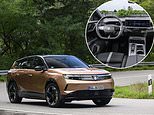 Has Vauxhall's grand plans for its new Grandland SUV paid dividends?
Has Vauxhall's grand plans for its new Grandland SUV paid dividends? -
 Aston Martin Vanquish: Britain's new brute of a sports car tested
Aston Martin Vanquish: Britain's new brute of a sports car tested -
 Renault 5 EV: Can it recreate the character and charm of the original?
Renault 5 EV: Can it recreate the character and charm of the original? -
 Polestar 4 EV: The first car sold in Britain WITHOUT a rear window
Polestar 4 EV: The first car sold in Britain WITHOUT a rear window -
 We take to the wheel of Ferrari's stunning new £336k 12Cilindri GT car
We take to the wheel of Ferrari's stunning new £336k 12Cilindri GT car -
 China's new sub-£16k EV: Leapmotor T03 arrives in UK with low price
China's new sub-£16k EV: Leapmotor T03 arrives in UK with low price -
 Peugeot E-5008: Is the £49k SUV the choice for eco-conscious families?
Peugeot E-5008: Is the £49k SUV the choice for eco-conscious families? -
 Ducati's new £30,000 Panigale V4 S costs the same as a small Mercedes
Ducati's new £30,000 Panigale V4 S costs the same as a small Mercedes -
 Is the new £22k MG ZS hybrid family-friendly SUV a genuine bargain?
Is the new £22k MG ZS hybrid family-friendly SUV a genuine bargain? -
 This £100k Volvo has driven me to distraction: EX90 SUV driven
This £100k Volvo has driven me to distraction: EX90 SUV driven -
 VW Touareg is a luxury SUV for a lower price - why is it so unpopular?
VW Touareg is a luxury SUV for a lower price - why is it so unpopular? -
 We test the new MG HS - Britain's favourite budget-friendly family SUV
We test the new MG HS - Britain's favourite budget-friendly family SUV -
 We test drive the £15,000 Dacia Spring - the UK's CHEAPEST new EV
We test drive the £15,000 Dacia Spring - the UK's CHEAPEST new EV -
 Suitable for UK climates: You can enjoy Mercedes CLE Cabrio year round
Suitable for UK climates: You can enjoy Mercedes CLE Cabrio year round -
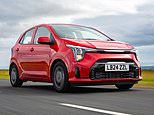 Kia's affordable Picanto offers a fun and nippy drive in the big city
Kia's affordable Picanto offers a fun and nippy drive in the big city -
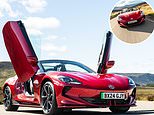 MG Cyberster review - convertible EV costs £60k and is fun to drive
MG Cyberster review - convertible EV costs £60k and is fun to drive -
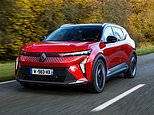 'Euros' winning Renault Scenic E-Tech gets Ray Massey's vote
'Euros' winning Renault Scenic E-Tech gets Ray Massey's vote -
 Ford Explorer: Is the £40k electric SUV a good buy for UK drivers?
Ford Explorer: Is the £40k electric SUV a good buy for UK drivers? -
 Polestar 3: Does the Tesla Model Y now have a real fight on its hands?
Polestar 3: Does the Tesla Model Y now have a real fight on its hands? -
 Lotus Eletre is an EV Lamborghini Urus rival: The hyper-SUV tested
Lotus Eletre is an EV Lamborghini Urus rival: The hyper-SUV tested -
 Dacia's new Duster is here - has it lost its value-for-money appeal?
Dacia's new Duster is here - has it lost its value-for-money appeal? -
 Alfa Romeo Tonale review: Can this SUV bring some sporting thrill?
Alfa Romeo Tonale review: Can this SUV bring some sporting thrill? -
 In a world of SUVs, can the VW Passat re-energise the estate market?
In a world of SUVs, can the VW Passat re-energise the estate market? -
 Ineos Quartermaster review: The new premium pick-up truck in town
Ineos Quartermaster review: The new premium pick-up truck in town -
 Peugeot e-3008 is attractive, sprightly and has a 326-mile range
Peugeot e-3008 is attractive, sprightly and has a 326-mile range -
 New £165k Aston Martin Vantage tested - is it better than a Ferrari?
New £165k Aston Martin Vantage tested - is it better than a Ferrari? -
 Can BMW harness the magic of the original Mini in an EV made in China?
Can BMW harness the magic of the original Mini in an EV made in China? -
 Is this the ultimate open-top super tourer? Aston Martin DB12 Volante
Is this the ultimate open-top super tourer? Aston Martin DB12 Volante -
 New Fiat 600e EV family car is here, but should wait for the hybrid?
New Fiat 600e EV family car is here, but should wait for the hybrid? -
 VW Tiguan review: Brand's best-selling SUV is back - but is it better?
VW Tiguan review: Brand's best-selling SUV is back - but is it better? -
 Should you consider the Mini Countryman EV instead of the petrol?
Should you consider the Mini Countryman EV instead of the petrol? -
 Another BMW goes electric - we test the new iX2 vs its petrol X2 rival
Another BMW goes electric - we test the new iX2 vs its petrol X2 rival -
 The 2024 Range Rover Evoque plug-in hybrid is a home-grown winner
The 2024 Range Rover Evoque plug-in hybrid is a home-grown winner -
 Britain's favourite car DRIVEN - we review the best-selling Ford Puma
Britain's favourite car DRIVEN - we review the best-selling Ford Puma -
 BMW's i5 EV offers supercar performance in an exec saloon package
BMW's i5 EV offers supercar performance in an exec saloon package -
 We drive the £76,000 Kia EV9 - Korea's all-electric Range Rover rival
We drive the £76,000 Kia EV9 - Korea's all-electric Range Rover rival -
 Has the BMW M3 Touring been worth the three-decade wait? Our review
Has the BMW M3 Touring been worth the three-decade wait? Our review -
 Has Britain's most popular small car just got much better? New Corsa
Has Britain's most popular small car just got much better? New Corsa -
 Volvo EX30 review: Sweden's new 'green' pocket rocket SUV rival Tesla
Volvo EX30 review: Sweden's new 'green' pocket rocket SUV rival Tesla -
 Is Renault's new Austral E-Tech SUV the complete package? We drive it
Is Renault's new Austral E-Tech SUV the complete package? We drive it -
 The Audi Q8 is annoyingly good for a 'sporty' coupe-style SUV
The Audi Q8 is annoyingly good for a 'sporty' coupe-style SUV -
 Ferrari Roma Spider costs £210k - here's what you get for your money
Ferrari Roma Spider costs £210k - here's what you get for your money -
 China's all-electric BYD Dolphin lands ashore - we test it on UK roads
China's all-electric BYD Dolphin lands ashore - we test it on UK roads -
 Our epic road test through Demark and Sweden in the new Polestar 2
Our epic road test through Demark and Sweden in the new Polestar 2 -
 New Abarth 500e convertible is a rare treat - it's electric and sporty
New Abarth 500e convertible is a rare treat - it's electric and sporty -
 Honda's new CR-V is bigger than its predecessor - but is it better?
Honda's new CR-V is bigger than its predecessor - but is it better? -
 We beat the new Bond to test his new car: Aston Martin DB12 review
We beat the new Bond to test his new car: Aston Martin DB12 review -
 Behind the wheel of Rolls-Royce's Spectre: We test the new EV Roller
Behind the wheel of Rolls-Royce's Spectre: We test the new EV Roller -
 Skoda's crowning glory: Superb L&K 4x4 Estate with extras driven
Skoda's crowning glory: Superb L&K 4x4 Estate with extras driven -
 Maserati Grecale test - the SUV with 50% of sales projected for women
Maserati Grecale test - the SUV with 50% of sales projected for women -
 Dacia's budget family car with seven seats! The £18,000 Jogger tested
Dacia's budget family car with seven seats! The £18,000 Jogger tested -
 This Q8 is just great: We take Audi's new Sportback e-tron for a spin
This Q8 is just great: We take Audi's new Sportback e-tron for a spin -
 Enter the Dragon! BYD Atto EV is the Chinese company's first UK model
Enter the Dragon! BYD Atto EV is the Chinese company's first UK model -
 Ferrari's first four-door family car: New £313,000 Purosangue driven
Ferrari's first four-door family car: New £313,000 Purosangue driven -
 Thrills without frills: £31,000 MG5 is one of the cheapest family EVs
Thrills without frills: £31,000 MG5 is one of the cheapest family EVs -
 Renault's Arkana ticks all the boxes for what car-buying Britons want
Renault's Arkana ticks all the boxes for what car-buying Britons want -
 Can Peugeot's chic 408 hybrid crossover be a hit in the UK? We test it
Can Peugeot's chic 408 hybrid crossover be a hit in the UK? We test it -
 We drive the Civic Type R - the rebellious bad boy in Honda's line-up
We drive the Civic Type R - the rebellious bad boy in Honda's line-up -
 Rolls Royce Spectre: What's it lke to drive the first ELECTRIC Roller?
Rolls Royce Spectre: What's it lke to drive the first ELECTRIC Roller? -
 Ineos Grenadier driven: Sir Jim Ratcliffe's £69,000 Defender
Ineos Grenadier driven: Sir Jim Ratcliffe's £69,000 Defender -
 Can you really live with a tiny Citroen Ami? Seven tasks in seven days
Can you really live with a tiny Citroen Ami? Seven tasks in seven days -
 Don't supersize me! Is the 'smaller' Volvo XC60 all the SUV you need?
Don't supersize me! Is the 'smaller' Volvo XC60 all the SUV you need? -
 We pamper some passengers in the new £211k Bentley Bentayga
We pamper some passengers in the new £211k Bentley Bentayga -
 New kind of Buzz! VW's electric MPV still feels like a hippy campervan
New kind of Buzz! VW's electric MPV still feels like a hippy campervan


